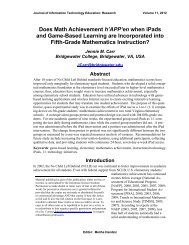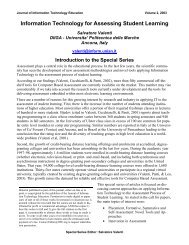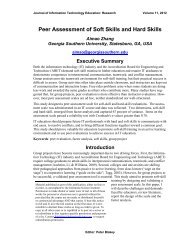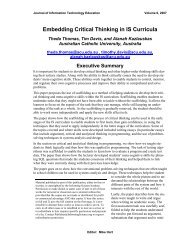Collaborative Learning in Online Study Groups - Journal of ...
Collaborative Learning in Online Study Groups - Journal of ...
Collaborative Learning in Online Study Groups - Journal of ...
Create successful ePaper yourself
Turn your PDF publications into a flip-book with our unique Google optimized e-Paper software.
<strong>Collaborative</strong> <strong>Learn<strong>in</strong>g</strong> <strong>in</strong> Onl<strong>in</strong>e <strong>Study</strong> <strong>Groups</strong>: An EGT Perspective<br />
Similar to the f<strong>in</strong>d<strong>in</strong>gs <strong>of</strong> previous studies <strong>in</strong> this area (e.g., F<strong>in</strong>egold & Cooke, 2006; Vonderwell,<br />
2003), the majority <strong>of</strong> the students’ comments reflected their concern about the level <strong>of</strong> participation<br />
<strong>of</strong> other group members. A related, albeit not very prom<strong>in</strong>ent, theme is the students’<br />
concern about the so-called “free riders”, i.e., students who do not put much effort <strong>in</strong> the group’s<br />
work but reap the benefits <strong>of</strong> the work done by the other group members. We believe that this<br />
theme, frequently found <strong>in</strong> previous similar studies (e.g., Br<strong>in</strong>dley et al., 2009; Roberts & McInnerney,<br />
2007), was not as prevalent <strong>in</strong> our study because the students were required to write and<br />
submit their assignments <strong>in</strong>dividually. Another related theme is the difference <strong>in</strong> the observed<br />
skills and/or knowledge <strong>of</strong> the group members lead<strong>in</strong>g to an <strong>in</strong>ability <strong>of</strong> group members to contribute<br />
at the same level; aga<strong>in</strong>, this is consistent with the f<strong>in</strong>d<strong>in</strong>gs <strong>of</strong> some previous studies (e.g.,<br />
Piezon & Ferree, 2008; Roberts & McInnerney, 2007).<br />
The impediments to group work caused by the employed technology, specifically asynchronous<br />
onl<strong>in</strong>e discussion channels, were also reported by many students as the reason for their lack <strong>of</strong><br />
participation. The importance <strong>of</strong> timely responses and synchronous means <strong>of</strong> communication is<br />
further acknowledged <strong>in</strong> the students’ suggestions for improv<strong>in</strong>g the group work – a significant<br />
number <strong>of</strong> suggestions were related to the availability <strong>of</strong> different communication channels, especially<br />
voice communication, for <strong>in</strong>teractions among group members.<br />
The lack <strong>of</strong> social connections and, thus, the establishment <strong>of</strong> the feel<strong>in</strong>g <strong>of</strong> mutual trust were also<br />
recognised by the students as someth<strong>in</strong>g that negatively <strong>in</strong>fluenced their level <strong>of</strong> participation <strong>in</strong><br />
the group work. This is fully consistent with the previous research work that has explored the role<br />
<strong>of</strong> social presence <strong>in</strong> onl<strong>in</strong>e learn<strong>in</strong>g sett<strong>in</strong>gs (Garrison & Arbaugh, 2007).<br />
Reluctance to commit to (yet) another social channel is a theme that we did not observe <strong>in</strong> the<br />
previous similar studies, but someth<strong>in</strong>g to be expected s<strong>in</strong>ce the majority <strong>of</strong> today’s students are<br />
used to communicat<strong>in</strong>g and shar<strong>in</strong>g ideas, <strong>in</strong>formation, and digital resources over general-purpose<br />
onl<strong>in</strong>e social networks such as Facebook. Commitment to another social network requires additional<br />
time and attention that they are not easily will<strong>in</strong>g to devote.<br />
The Perceived Advantages and Disadvantages <strong>of</strong> Onl<strong>in</strong>e Group<br />
Work and the Students’ Participation Level<br />
Our second research question (RQ2) was aimed at explor<strong>in</strong>g whether some <strong>of</strong> the advantages and<br />
disadvantages <strong>of</strong> onl<strong>in</strong>e group work perceived by the students could expla<strong>in</strong> the students’ level <strong>of</strong><br />
participation <strong>in</strong> collaborative group work (<strong>in</strong> the scope <strong>of</strong> Tasks 2 and 4). To address this research<br />
question, we first computed the number <strong>of</strong> active and <strong>in</strong>active participants <strong>in</strong> each study group,<br />
and then classified all groups <strong>in</strong>to Active, Borderl<strong>in</strong>e or Inactive categories. All the computations<br />
were done follow<strong>in</strong>g the rules given <strong>in</strong> the Data Analysis section.<br />
Figure 2 presents the percentages <strong>of</strong> Active, Borderl<strong>in</strong>e and Inactive groups. The figure clearly<br />
shows that the Active groups constituted around only 22% <strong>of</strong> all the study groups. This was despite<br />
the themes <strong>of</strong> perceived advantages dom<strong>in</strong>at<strong>in</strong>g over perceived disadvantages (as shown <strong>in</strong><br />
the previous section). We tried to understand this low participation level by compar<strong>in</strong>g students’<br />
perceptions <strong>of</strong> pros and cons <strong>of</strong> onl<strong>in</strong>e group work across the groups <strong>of</strong> different participation<br />
levels.<br />
92










